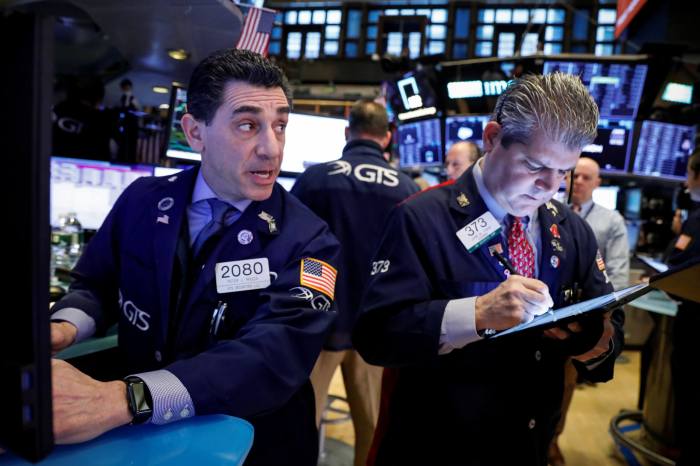By Tommy Wilkes
LONDON (Reuters) – Amid frenzied selling in financial markets this week, there was a silver lining for banks and trading platforms which attracted a rush of business as investors scrambled to protect portfolios from the volatility.
European stock trading volumes swelled on Monday to more than three times their 90-day daily average, according to Refinitiv data, as share prices suffered their biggest one-day drop since the 2008 financial crisis and oil prices plunged 25%.
Ten days into March, European share trading volumes have already hit more than half their February total, Refinitiv data shows.
The resurgence will be welcomed by traders. London-based inter-dealer broker TP ICAP
“We had reached record volumes, with clients hedging, rebalancing their portfolios … a lot of intense activity,” Breteau said, adding that while the environment affected clients, the volatility offered TP ICAP an opportunity that “gives us confidence for the future.”
Before March, trading desks at banks and elsewhere had suffered a prolonged period of low volatility and lacklustre volumes, crimping profitability.
Typically, more volatile markets encourage traders to buy and sell more often, handing more revenue to market makers that charge a spread on each transaction.
Volumes are now rebounding across asset classes.
Turnover of currency futures topped $200 billion on Monday, more than double the daily average reported year-to-date, data provided to Reuters by CME showed. That included more than $70 billion of trading in euro/dollar and $49 billion in dollar/yen.
EBS, which runs one of the world’s biggest FX platforms, declined to give data for Monday but told Reuters that volumes in the four days to last Thursday had run 80% above 2019 averages.
Volumes in G10 currencies were nearly double their 2019 daily average, EBS said.
Refinitiv, another big forex market player, said Monday had been its busiest day for spot currency trading since the U.S. Presidential Election in November 2016.
The company declined to give the dollar value for Monday’s volumes but said activity on its FX Matching platform was more than double the daily average traded during February.
Markets are now the most volatile since the financial crisis more than a decade ago.
Wall Street’s so-called fear gauge <.VIX> has reached its most elevated since 2008, U.S. Treasury market volatility <.MOVE> the highest since 2009, and price swings in the FX market are at three-year highs.
(Graphic: Market volatility soars – https://fingfx.thomsonreuters.com/gfx/mkt/13/3081/3046/market%20vol.png)
BOND TRADING
Bond trading platforms are also reporting increased activity as clients dump riskier bonds and pile into the safety of government debt such as U.S. Treasuries, where yields have collapsed to record lows.
However, the rise in volumes last week was not dramatic and Monday actually saw reduced activity, suggesting many investors had stuck to the sidelines.
MarketAxess, which runs a major fixed-income platform and tracks trading flows, said market-wide trading of government and corporate bonds by European investors totaled 136.8 billion euros ($155.5 billion) on Monday. That compared with a daily average of 190 billion euros last week.
Daily volumes in 2020 have ranged from as low as 78 billion euros to as high as 228 billion euros, MarketAxess data showed.
Tradeweb, another company running a large bond trading platform, declined to give specific numbers.
“While we don’t report our trading activity on a daily basis, we continue to experience strong volumes across our platforms in line with broader market volatility,” Tradeweb said.
There is some evidence that the jump in volatility may also be undermining liquidity – the ease with which buyers and sellers can transact without moving the price.
Prior to Monday, traders say frenzied trading activity had generally been orderly.
“In the morning, we tried to trim a position in the benchmark 30-year US Treasury bond and were shocked when several dealers were reluctant to show us a firm price, something we can’t remember ever happening before,” TwentyFour Asset Management said in a daily note, referring to Monday.
“Normal service resumed shortly afterward, but to us this was a stark illustration of the sheer panic that permeated the market.”
(This story has been refiled to amend paragraph 20 to make clear MarketAxess data is market-wide)
(Reporting by Tommy Reggiori Wilkes; Additional reporting by Thyagaraju Adinarayan in London and Muvija M in Bengaluru; Editing by Susan Fenton)

















